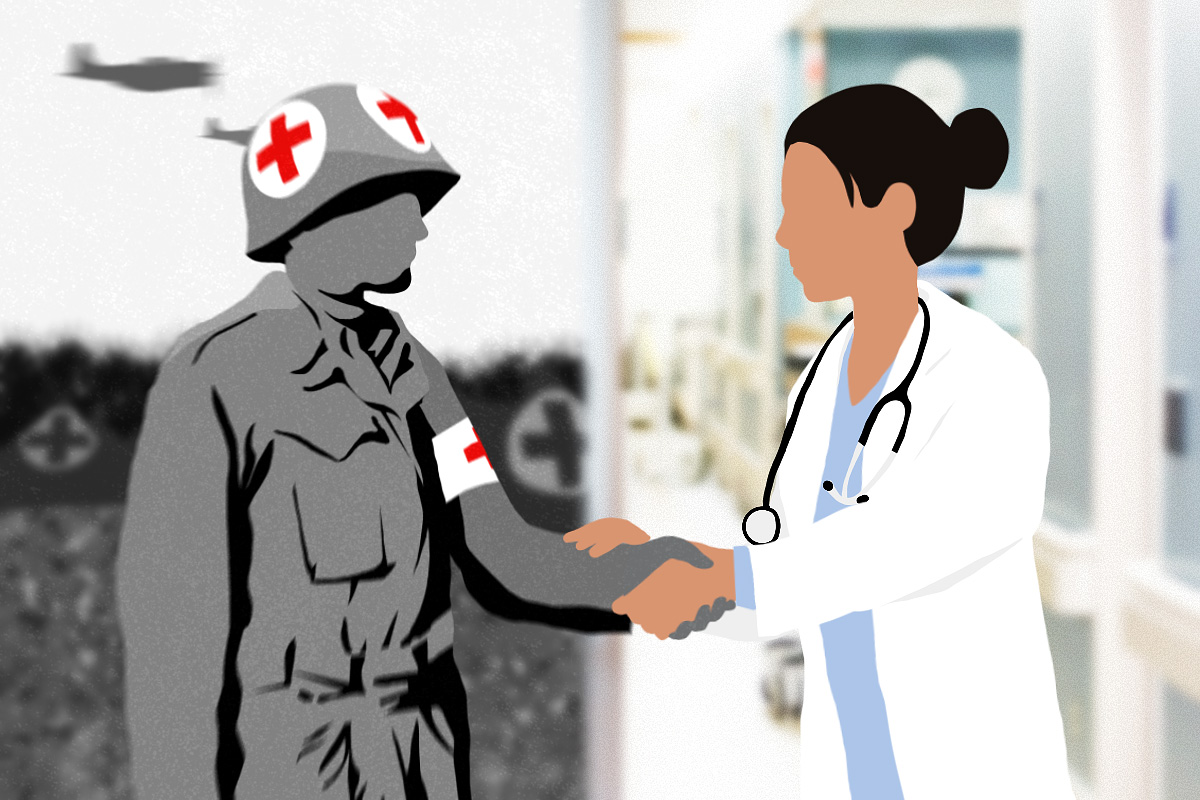How A Wartime Program to Support U.S. Troops Fueled Decades of Medical Research
How A Wartime Program to Support U.S. Troops Fueled Decades of Medical Research
Professor Daniel P. Gross explains how a federal wartime effort underpinned decades of biomedical progress and inspired the modern NIH
An “unprecedented” federal program to support troops’ medical needs in World War II led to the emergence of the modern US biomedical system, spurring decades of expansion in medical research and drug discovery.
It also demonstrated the potential of application-oriented approaches to research policy, which may offer lessons to the US system of government-funded science, including at the National Institutes of Health (NIH).
This is according to the paper, “The Therapeutic Consequences of the War: World War II and the 20th-Century Expansion of Biomedicine,” co-authored by Daniel P. Gross of Duke University’s Fuqua School of Business and Bhaven Sampat of Arizona State University.
In their research, Gross and Sampat describe how a new federal agency, the Committee on Medical Research (CMR), coordinated the “U.S. government’s first substantial investment in medical research.”
Then as today, the authors write, keeping soldiers healthy was a crucial priority for the US military. CMR partnered with universities and private research labs to find solutions to military medical challenges — from infectious diseases to explosive injuries to physiological stressors — and worked to link science to technology development, manufacturing and distribution.
These efforts fostered long-lasting changes in medical research and practice, the researchers write, driving modernization in the U.S. pharmaceutical industry and creating the conditions for a golden age in drug discovery, while paving the way for the re-imagining of the postwar NIH.
“These effects were a product of a highly integrated approach to research and development rarely seen today,” Gross said, “perhaps with a few rare exceptions such as COVID’s Operation Warp Speed.”
How CMR changed medical research
Before World War II, there was very little federal funding for medical research, which was primarily supported by private foundations, Gross explained. At the time, the pharmaceutical industry was also “primitive and disorganized,” broadly operating through “trial-and-error” approaches to drug discovery rather than science, he said.
With the war bringing new urgency to solving problems such as traumatic injuries or bacterial and viral infections, the US government created the Committee on Medical Research (CMR), a division of the US Office of Scientific Research and Development in charge of funding and coordinating research targeting military medical needs.
As a research funding agency, CMR was innovative for its time, and would be distinctive even today, Gross said. Functionally, it set priorities, solicited proposals from universities, companies and hospitals, coordinated a peer-review process, and funded projects based on their potential impact on war operations.
But this was only the first step of its work, the authors write. Once funds were awarded, CMR actively managed the R&D process, organizing and coordinating all civilian organizations involved and facilitating clinical testing, large-scale production, and deployment of newly discovered drugs or technologies.
“It was truly problem-driven,” Gross said. “There were problems that urgently needed solving, and CMR created the institutional infrastructure for meeting that need.”
The long-lasting effects of CMR’s effort … at the cost of 4 hours of military operations
The researchers found that while CMR's immediate focus was solving wartime medical challenges — and despite being closed down when the war ended — its impact extended to decades of continued advances in basic science and drug innovation. Notable examples include:
- Research subjects with CMR funding generated 50-100% more scientific articles per year after the war compared to pre-war levels;
- Drug categories which were a target of CMR investment saw significantly more new drugs introduced in the 1950s and 1960s;
- Firms engaged in CMR-coordinated drug development projects entered a two-decade period of accelerated drug discovery.

Overall, the CMR operations created a wide range of R&D assets that companies and researchers built upon in the following decades, the authors write.
An example of this success was the CMR’s penicillin project, which opened up a postwar new era of penicillin innovation and antibiotic development.
The price of this scientific progress?
Gross and Sampat estimate that the U.S. government spent the equivalent of about “four hours of World War II military operations” on CMR – “a rounding error in the context of a global war,” Gross said, but one which helped allies win the war and helped save innumerable lives in the years afterwards.
Reversing the science-to-application model
The traditional understanding of the link between science and technology assumes that basic research spills over into technological innovation with practical applications and commercial products, Gross said.
However, the experience of CMR in World War II demonstrated that this logic sometimes may work in reverse: focusing on specific problems can yield breakthroughs in scientific knowledge.
In their paper, Gross and Sampat mentioned the example of the need to develop effective blood substitutes and preservatives. CMR’s work on blood separation opened up a number of new opportunities for research on the function and therapeutic potential of different blood components, which eventually supported new blood-based therapies.
What lessons of wartime policy can be applied today?
The war presented urgent problems for biomedical science, but in addressing those immediate needs, it also created an institutional apparatus which ultimately provided the seed kernel for the current NIH approach to funding research at universities, Gross noted.
This included the very idea of federal funding for biomedical research, as well as specific implementation details such as indirect cost policy and procedures for peer review, he said.
However, in contrast to the way NIH works today, “CMR took a very integrated approach that connected science to engineering to manufacturing, all the way through to the adoption and implementation of new techniques and therapies at scale,” Gross said.
There is no such coordinating mechanism in the modern US innovation system, Gross noted, which is characterized by a much sharper division of labor between university labs and the companies using their discoveries to develop new products and services.
The experience of CMR may suggest an opportunity for the NIH to experiment with different approaches to research funding, Gross suggested, “including more application-driven, use-oriented and integrative research models, like those we saw in World War II and, partially, during the COVID pandemic.”
Investing now to reap later
A crucial difference in research policy in ordinary times and in times of crisis (such as a war or pandemic) is that during crises there is little time to invest in science, which is often slow and unpredictable, Gross said. As an example, “Operation Warp Speed took existing science off the shelf and applied it to vaccine design and then ultimately production, first in prototypes and then at scale,” he said.
That crisis innovation often draws on the existing stock of knowledge points to one reason why governments should keep supporting basic research, Gross said.
”Vannevar Bush — architect of the World War II research effort and a key visionary for modern U.S. federal R&D policy — once wrote that ‘basic science is the pacemaker of technological progress.’ Our work takes this logic one step further: government investment in basic research in non-crisis times is also a down payment to make sure those resources are available when the next crisis arrives,” he said.
This story may not be republished without permission from Duke University’s Fuqua School of Business. Please contact media-relations@fuqua.duke.edu for additional information.

